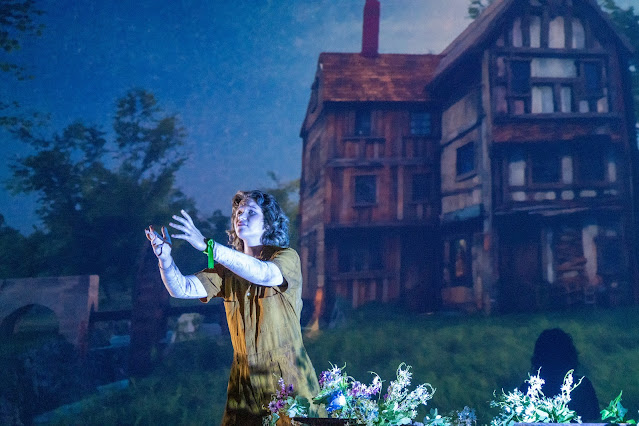 |
| Mezzo-soprano Hope Nelson in Long Beach Opera’s staging, with backdrops, of Schubert’s Die Schöne Müllerin. |
REVIEW
Long Beach Opera, The Art Theatre, Long Beach
RODNEY PUNT
For its season finale the last weekend of June, titled "The Recital", Long Beach Opera turned itself into mostly a film festival, with two 5-hour days of screenings at San Pedro's Art Theatre (right). LBO Artistic Director James Darrah handed program planning to guest co-curators Tom C. J. Brown and Raviv Ullman, and music direction to Rakefet Hak. A pairing of film and live song on Sunday, June 25 caught my eye.
Performed on both days, with a different slate of films, was a staged recital of Franz Schubert’s poignant 1823 song-cycle, Die Schöne Müllerin D. 795, followed by an animated film produced by Brown, Christopher at Sea, which thematically linked to the Schubert with snippets of its music and the shared atmospherics of loneliness. Both works also involved fearsome encounters with water.
Christopher at Sea, animated with expressionistic black lines alternately tinted in blue, red, green, or yellow, tells the story of a lad’s near isolation on a storm-tossed freighter crossing the Atlantic. Wary of the gruff crew, he has hallucinatory nightmares. In one bathroom scene on the pitching ship, he is shocked by someone’s urine flowing toward him on the floor. But having endured such fears, his emotions calm when a kind man befriends him with love and assurance.
 |
| Franz Schubert. |
 |
| Wilhelm Müller. |
Song cycles are usually sung in concert halls, with singer and pianist dressed in concert attire. Any action depicted takes place only in the imaginations of audience members. But this fully staged Schöne Müllerin, on a shallow riser in front of the film screen, had an entirely different feel. It was brought to vivid physical life with large video projections (by designers Jack Wedge and Will Freudenheim), charmingly illustrating an idealized Romantic-era Austrian countryside, with its village watermill and a miller’s home nearby. Various props (fabricated by Jen Dunlap) helped to theatricalize the many incidents of the songs.
It seemed at first that co-curators Brown and Ullman were out to fashion a work of naïve nostalgia by replicating the zeitgeist of Schubert’s early 19th century. Hard-bitten modernists might accuse its painterly mise-en-scènes of shameless kitsch. But, as a century or more has passed since such Romantic-era scenes had become clichés, the effect was more an encounter with long-lost charm, as if the Romantic wanderer in this story had just arrived at an idealized home and hearth.
But a disruptive element was imbedded in the charming pictorialism. The casting of the miller boy was not the bright-voiced tenor one usually encounters in this work, but a mezzo-soprano named Hope Nelson. Tall, big-boned, and dressed in brown work pants and shirt, she suggested tomboys of yore on cinema and TV, like perhaps the similarly clad Doris Day of the 1953 film Calamity Jane, or the stage’s Annie Oakley, the sharpshooter who can’t get a man with a gun. With this gender casting, a subtext of sexual ambiguity had been introduced.
A work for traditional piano and natural voice, Die Schöne Müllerin registers best in the lively acoustics of a concert hall. The limited resonance of the Art Theatre, designed for film, provided little sonic warmth for Nelson to float her vocalizations in Sunday’s repetition of the song recital, each over an hour’s length. To her singing were additional duties as actress, with props and projections around which to navigate. Singing this work on two consecutive days could have posed both an artistic and physical challenge. But throughout, Nelson’s performance was compelling. Her rendition of all the songs, particularly the farewell lullaby, Des Baches Wiegenlied, was warm and moving.
 |
| Sky Haneul Lee (left) with Hope Nelson. |
But more was going on this day than a vocal recital, more even than the novelty of its staging. As staged here, an examination of gender implications within Schubert's masterpiece was underway.
So-called “trouser roles” have much precedent in opera. Mozart’s Cherubino in The Marriage of Figaro and Richard Strauss’s Octavian in Der Rosenkavalier are prominent examples. In these works, female singers perform dramatic roles intended as adolescent males who pursue love interests with older females.
In terms of poet Müller’s literary characters, however, Nelson's height and sturdy frame seems almost make more dramatic sense had she been perceived as the rival hunter lad than the sensitive miller boy. But what if Nelson is, within the story itself, a female disguising herself as a boy, rather than an actual adolescent boy? Beethoven’s opera Fidelio has such a trouser role, but the audience knows that Leonora assumes her disguise as the “male” Fidelio to gain access to a jail to free her husband. Gender pretense will resolve as conventional heterosexual love.
This production seems to have introduced intentional sexual ambiguity in the casting of Ms. Nelson as the miller boy. Is “she” a boy thwarted in his first love? Or is she a tomboy who had disguised herself as a boy to get the miller apprentice job, but then found herself attracted to the pretty maid of the mill? The societal insecurity of same-sex love would then collide with the personal jealousy of competing with a man for the same girl. The psychological drama takes on far more complexity.
 |
| Q&A with (l-r) James Darrah, Tom C. J. Brown, and Raviv Ullman. |
“…to make Christopher at Sea, Brown lived in his film’s setting on a large cargo vessel at sea and used historic recordings of Schubert’s song cycle as constant inspiration for the queer-focused intimate story, the score, and the mood of his animated work.”
Common to both works as poetic sub-text is the mood-swing personality of Nature’s mysterious waters: the friendly but fatal water of the miller boy’s stream, and the unfriendly but ultimately forgiving water of Christopher’s ocean. The fear and loneliness of the shipbound lad in the Atlantic finds a male who loves him, but the hapless trouser-rolled apprentice in love with a girl in the Schubert does not.
Difficult enough to sort out when attractions are heterosexual, how much more fraught with unknown consequence can attractions be in same-sex relationships, as was artistically exampled between Schubert’s tomboy and the miller girl, or a young man and a sympathetic sailor in Christopher at Sea?
The point reinforces the modern view that gay lifestyles are a mainstream human condition and should be normalized in all cultures today. As I once heard observed: “What’s wrong with gay love? After all, it’s the second most popular form of love for humankind.”
Indeed.
---ooo---
Long Beach Opera, The Art Theatre, 2025 E. 4th St., Long Beach, CA 90814, Sunday, June 25, 2023, 12:00 p.m.
Images: Theater exterior: Bronson Foster for Long Beach Opera; Film still: Director website; Müller, Schubert: Wikimedia Commons; The performance: Jordan Geiger for LBO; Q&A: Katie Speer for LBO.





















